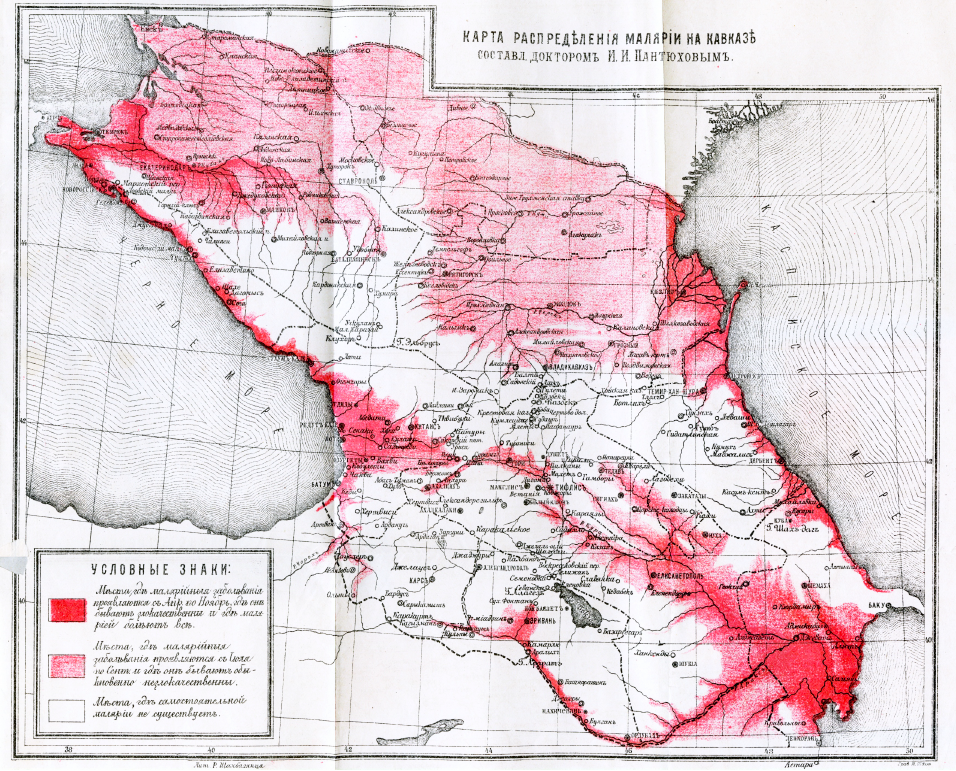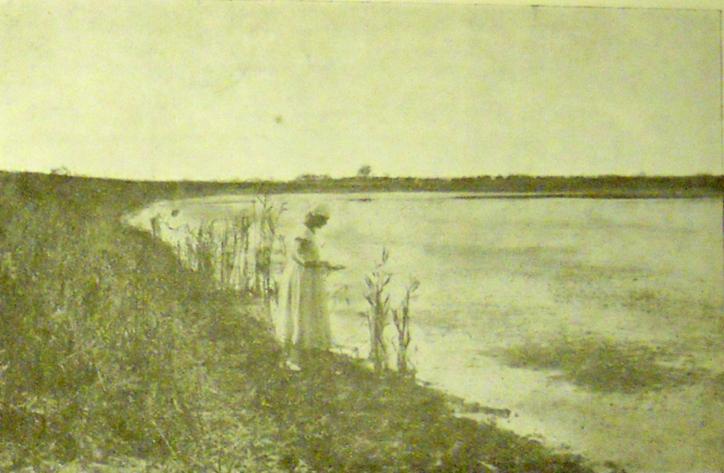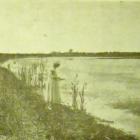In Tbilisi, 1898, the military doctor Ivan Pantiukhov published an article titled “On the Influence of Malaria on the Colonization of the Caucasus.” An imperial physician assigned since 1889 as an inspector to the Caucasian Military District of the Russian Empire, Pantiukhov lamented that malaria “reigned over all the fertile valleys and the Caucasus plains,” and was one of the reasons for the resistance of the indigenous people to the colonization of the region for centuries. It has been a “constant assistant in the fight against foreign attacks,” he wrote.

Pantiukhov’s map of malaria distribution in the Caucasus, 1898.
Pantiukhov’s map of malaria distribution in the Caucasus, 1898.
Map by Ivan I. Pantiukhov, 1898.
Pantiukhov, Ivan. Vliyanie Malyarii na kolonizatsiiu Kavkaza. Reprint from Kavkaz. Tbilisi, 1898.
 This work is licensed under a Creative Commons Public Domain Mark 1.0 License.
This work is licensed under a Creative Commons Public Domain Mark 1.0 License.
The swampy valley regularly flooded by the Kura and Araks Rivers was a hotbed of Anopheles mosquitoes, vectors of malaria. Pantiuhkov described the Caucasian isthmus as “a healthy mountainous island surrounded by a sea of malaria with its countless bays and straits” in which “at the same time as the struggle with nature and the natives, foreign colonizers had to fight malaria.” Russian ideas on pathology and backwardness in the Caucasus, borrowed from European colonial anthropologists, helped connect discursively indigenous populations and parasites together in a “symbiotic relation.”
In his classic Mosquito Empires: Ecology and War in the Greater Caribbean, 1620–1914, John McNeill describes how Anopheles mosquitoes could turn out to be “imperial” or “revolutionary” depending on the “differential resistance” to the disease, which “consistently attack[ed] some populations more severely than others.” This ecology of war can be described mutatis mutandis during the Russian and Soviet conquest of the Caucasus.
At the end of the nineteenth century, the Russian colonization of the Caucasus was intensifying. While mountain people and nomads avoided more efficiently mosquitoes in the highlands, sedentary populations, settlers, and other “newcomers” to the region were more vulnerable to the disease in the valleys. In 1898, from the 80 families who had settled in the village of Bakhlanovka in the district of Sukhumi 20 years before, only 7 were left; the others had been decimated by the plague or had fled.
Imperial authorities were eager to improve the region both sanitarily and economically and a controversy among agronomists arose about the benefits and inconveniences of rice culture in the lowlands of the Mugan in Azerbaijan. While rice was considered as the most profitable crop for the region and its population by some, it was condemned as a breeding ground for mosquitoes to be eradicated by others.

A lake near the village of Novo-Donetsk (north of Mugan). A huge aquatic area inhabited in coastal areas by an extremely large number of Anopheles larvae.
A lake near the village of Novo-Donetsk (north of Mugan). A huge aquatic area inhabited in coastal areas by an extremely large number of Anopheles larvae.
Unknown illustrator, n.d.
Originally published in P. F. Zdorovskii, Malyariya na Mugani. Epidemiologiya i plan bor’by. Moscow-Baku: ASSR, Narodnyi Komissariat Zdravookhraneniya, 1926: 57.
 This work is licensed under a Creative Commons Public Domain Mark 1.0 License.
This work is licensed under a Creative Commons Public Domain Mark 1.0 License.
The destructive sequence of war, revolution, and civil war from 1914 to 1921 created new cataclysmic social and environmental disturbances in these ecologies of the Caucasus. During the First All-Russian Malaria Conference held in Moscow in January 1923, seven causes, biological and social, were highlighted to explain the “colossal” expansion of the disease:
1) the weakening of the population’s immunity by the exhaustion of the human body due to war and revolution,
2) the increase in annual temperature,
3) the constant displacement of human masses (refugees, military units),
4) the reduction of local medicine (decrease in demand, insufficient treatment, and increase in parasite carriers),
5) lack of quinine,
6) total cessation of work to rehabilitate and improve hydraulic structures,
7) famine and complete destruction of the economic well-being of entire regions, and in particular the number of head of cattle.—Trudy vtorogo Vserossiskogo S’ezda po Malyarii, yanvarya 1924 goda
Malaria, though, tended to strike more systematically a range of crucial actors considered as supporters of Russian authority and stability in the region, like soldiers and railway workers. While the railway administration of the North Caucasus registered 10,672 cases of contamination of its employees in 1911, the number skyrocketed to 63,966 in 1923. Red Army soldiers were the first new victims of malaria after the Bolsheviks seized Baku in spring 1920. From 1921 to 1922, the sickness rate in the Red Army as a whole rose from 5.39 percent to 15.5 percent, and the morbidity from 0.74 percent to 1.37 percent.
The soldiers’ and railway workers’ “lifestyle” (byt) was found to be an aggravating factor for the diffusion of the disease: outdoor economic activities, night rounds for the protection of wayside structures and military warehouses, and mobility of the army in connection with military and combat operations. Furthermore, according to one Red Army medical officer,
In times of peace, the army receives and sends hundreds of thousands of people back into the population every year, thus carrying out a systematic demobilization process, albeit on a smaller scale, with all the health consequences that this entails.
—Trudy vtorogo Vserossiskogo S’ezda po Malyarii, yanvarya 1924 goda
Be they Imperial settlers or Soviet soldiers, “newcomers” in the Caucasus both transformed the environments they invaded and became caught in the new threatening “inescapable ecologies” they created in the process. The region’s valleys and mountains, mosquitoes and swamps, remained indeed “constant assistants” of the indigenous populations against foreign invasions, before and after 1917. Malaria in the region decreased steadily after 1923, but the cataclysmic socio-environmental crisis caused by the upheavals of Stalin’s Great Break in 1929 was about to create anew threatening malarial outbreaks in the Caucasus.
How to cite
Coudreau, Marin. “‘A healthy mountainous island surrounded by a sea of malaria’: Ecology and War in the Caucasus.” Environment & Society Portal, Arcadia (Spring 2021), no. 4. Rachel Carson Center for Environment and Society. doi:10.5282/rcc/8381.
ISSN 2199-3408
Environment & Society Portal, Arcadia
 This work is licensed under a Creative Commons Attribution 4.0 International License.
This work is licensed under a Creative Commons Attribution 4.0 International License.
2021 Marin Coudreau
This refers only to the text and does not include any image rights.
Please click on an image to view its individual rights status
- Malyariya. Materialy po sanitarnomu sostoyaniiu Sev-Kavkazk. J.-D. Rostov-on-Don: NKZ. Otd. Putei soobscheniya, 1926.
- McNeill, John R. Mosquito Empires: Ecology and War in the Greater Caribbean, 1620–1914. Cambridge: Cambridge University Press, 2010.
- Moshkovskii, Sh., and P. Popov, Pervoe Vserossiskoe Soveschanie po bor'be s Malyariei. Reprint from Gigiena i Epidemilogiya. Moscow, 1923.
- Nash, Linda. Inescapable Ecologies: A History of Environment, Disease, and Knowledge. Los Angeles and Berkeley: University of California Press, 2006.
- Pantiukhov, Ivan. Vliyanie Malyarii na kolonizatsiiu Kavkaza. Reprint from Kavkaz. Tbilisi, 1898.
- Petrova, N., D. Pletneva, L. Tarasevicha, Slovtsova, and V. Liubarskovo. Malyariya. Sbornik statei. Moscow-Petrograd: Izdatel'stvo L. D. Frenkel', 1923.
- Trudy vtorogo Vserossiskogo S’ezda po Malyarii, yanvarya 1924 goda. Moscow: San.-prosvet. otd. Narkomzdrava, 1924.








